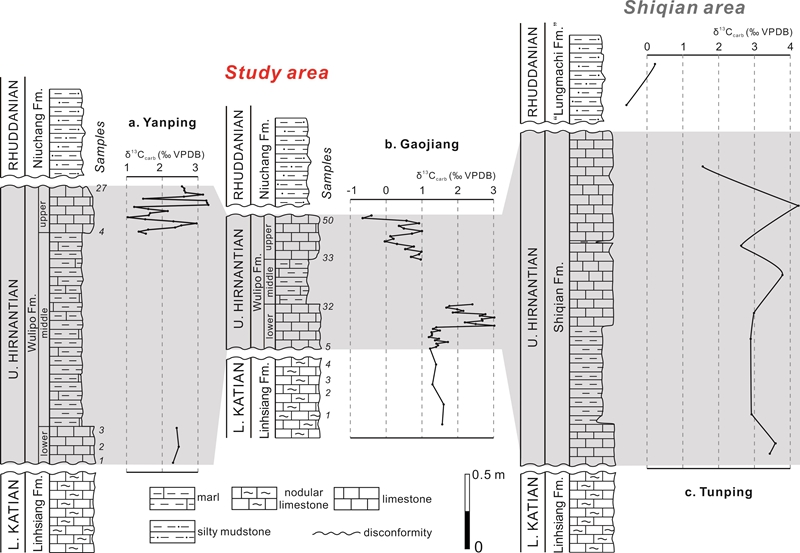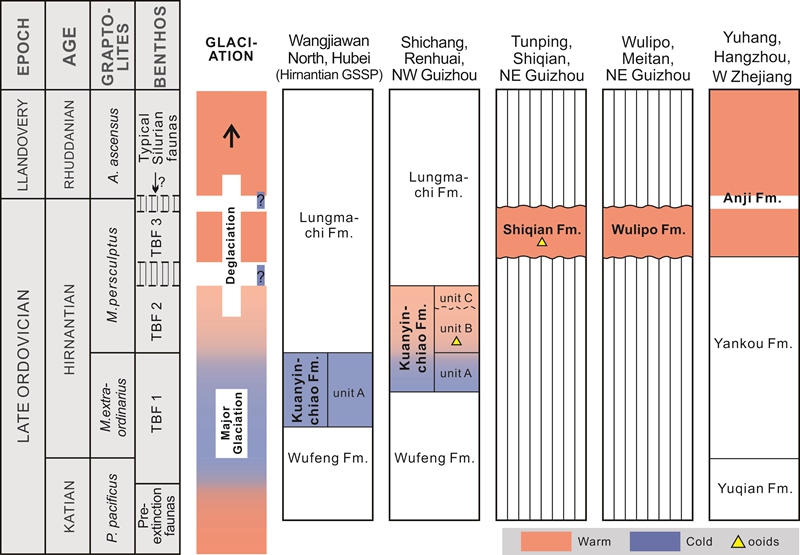The end-Ordovician mass extinction (EOME) was the first of the “Big Five” extinctions of the Phanerozoic. However, there is still uncertainty concerning the exact timing of the Silurian biotic recovery following this extinction event due to the lack of reliable age constraints of fossil records during this interval.
Of particular interest is the richly fossiliferous succession from the Wulipo Formation in the Huangjiaba area near Meitan in northern Guizhou, SW China, which represents one of the very rare records of shelly fauna across the Ordovician and Silurian transition worldwide, and is therefore crucial for understanding the pattern and dynamics of the end-Ordovician mass extinction (EOME). Recently, Dr. WANG Guangxu from Nanjing Institute of Geology and Palaeontology, Chinese Academy of Sciences and his colleagues present for the first time, chemostratigraphic data from the Wulipo Formation which confirm the presence of the Hirnantian Isotope Carbon Excursion (HICE). The research results have been published online in the international geoscience journal Geological Journal.
Historically, the Wulipo Formation was dated as middle Rhuddanian (early Silurian). However, its fauna shows a close affinity with Transitional Benthic Fauna 3 (TBF 3), now known to be confined within the late Hirnantian (latest Ordovician) in well-constrained successions globally. A critical review of faunal evidence further indicates a late Hirnantian age for this formation, and thus the hitherto only known anomalous TBF 3 record documented from South China is convincingly redated.
The important implication is that the substantial biotic recovery after the EOME commenced globally at the very beginning of the Silurian with an overall amelioration of physical conditions. The new findings also suggest a much wider distribution of postglacial warm-water benthic faunas on the Yangtze Platform during the late Hirnantian than previously envisaged.
This research was jointly funded by the National Natural Science Foundation of China, the Strategic Priority Research Program (B) of Chinese Academy of Sciences and the State Key Laboratory of Palaeobiology and Stratigraphy.
Related information on this paper: Wang, G.X.*, Wei, X., Luan, X.C., Wu, R.C., Percival, I.G. & Zhan R.B. 2020. Constraining the biotic transitions across the end-Ordovician mass extinction in South China: Bio- and chemostratigraphy of the Wulipo Formation in the Meitan area of northern Guizhou. Geological Journal, https://onlinelibrary.wiley.com/doi/full/10.1002/gj.3816.

δ13Ccarb curves from Yanping (a) Gaojiang (b) of the study area, in comparison with that from Tunping (c) of the Shiqian area, indicating the presence of HICE in the Wulipo Formation.

Download:
